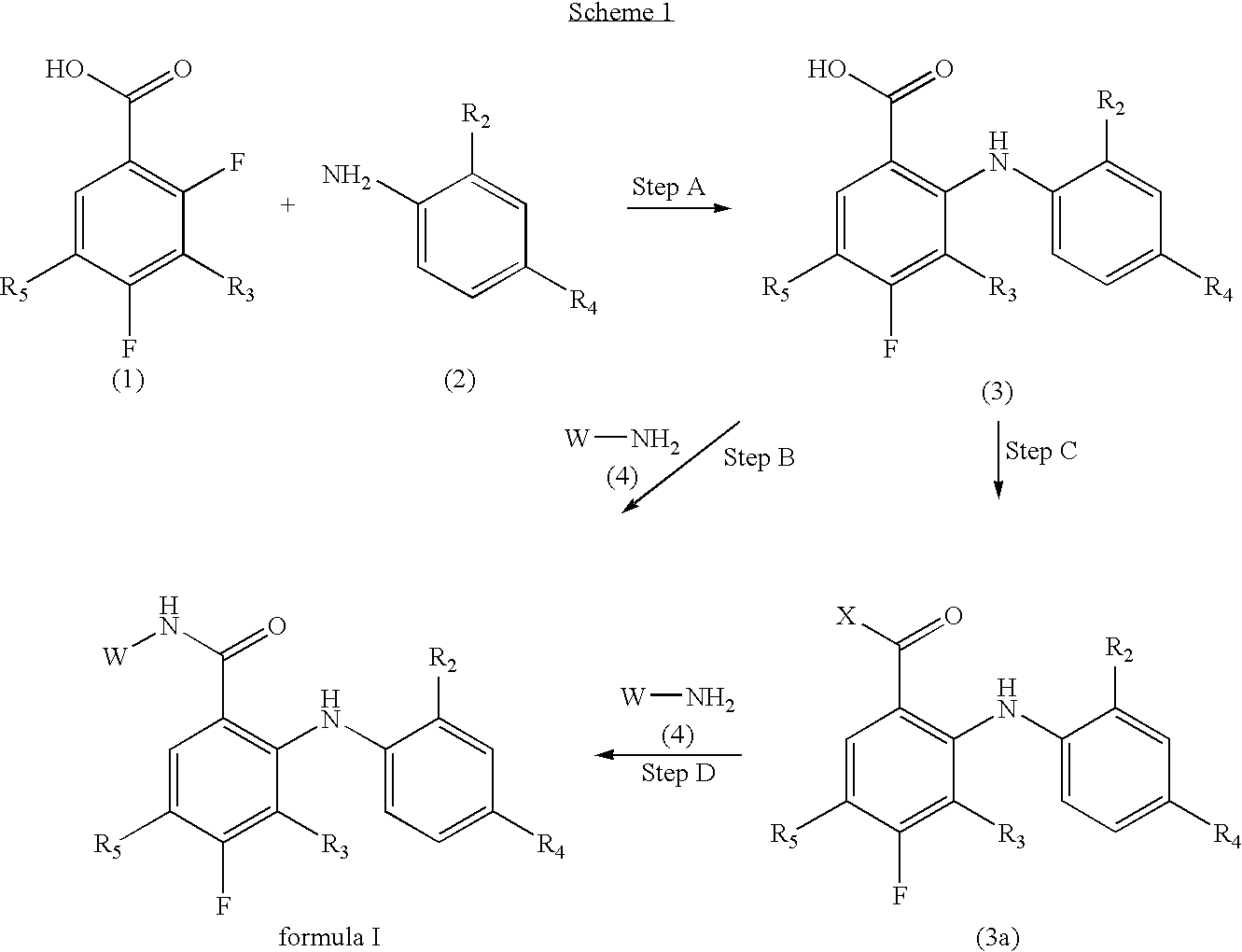N-(4-substituted phenyl)-anthranilic acid hydroxamate esters
a technology of phenylaminobenzhydroxamic acid and esters, which is applied in the direction of phosphorous compound active ingredients, drug compositions, biocides, etc., can solve the problem of mitogenic signals within the cell, and achieve the effect of reducing the number of mitogenic signals
- Summary
- Abstract
- Description
- Claims
- Application Information
AI Technical Summary
Problems solved by technology
Method used
Image
Examples
example 1
[0253]
2-[(4-Ethyl-2-fluorophenyl)amino]-3,4-difluoro-N-(2-hydroxyethoxy)benzamide
[0254]
Step A: Preparation of 2-fluoro-4-[(trimethylsilyl)ethynyl]aniline
[0255]2-Fluoro-4-iodoaniline (5.00 g, 21.1 mmol), CuI (90 mg, 0.42 mmol), and (Ph3P)2PdCl2 (300 mg, 0.42 mmol) were weighed into a flask which was sealed and flushed with N2. A solution of TMS-acetylene (2.28 g, 23.2 mmol) in TEA (20 mL) was added, then the entire mixture stirred 15 hours at room temperature. The reaction mixture was diluted with diethyl ether (200 mL), filtered through Celite®, then all solvents removed under reduced pressure. The resulting dark brown oil was purified by filtration through a plug of flash silica (5% EtOAc / hexanes as eluant) to afford the desired product as a pale brown oil which rapidly solidified to give a crystalline solid (3.85 g, 88%); m.p. (EtOAc / hexanes) 45-47° C. 1H NMR (400 MHz, CDCl3) δ 7.10 (dd, J=11.7, 1.8 Hz, 1 H), 7.06 (ddd, J=8.3, 1.8, 1.0 Hz, 1 H), 6.66 (dd, J=9.4, 8.3 Hz, 1 H), 3.86...
example 2
[0260]
2-(2-Chloro-4-phenylamino)-3,4-difluoro-N-(2-hydroxy-ethoxy)-benzamide
[0261]
Step A: Preparation of 2-(2-chloro-4-iodophenylamino)-3,4-difluorobenzoic acid
[0262]To a solution of 2,3,4-trifluorobenzoic acid (75 g, 0.426 mol) in anhydrous tetrahydrofuran at −78° C. under nitrogen was added slowly lithium bis(trimethylsilyl)amide (426 mL, 0.426 mol, 1.0 M solution in THF). The dark brown reaction mixture was stirred for 15 minutes at −65° C. (inside temp). This is referred to as Solution A.
[0263]To a solution of 2-chloro-4-iodoaniline (108 g, 0.426 mol) in anhydrous tetrahydrofuran (1000 mL) at −78° C. (outside) under nitrogen was added slowly lithium bis(trimethylsilyl)amide (852 mL, 0.852 mol, Aldrich, 1.0 M solution in THF). The dark green solution was stirred for 0.5 hours. This is referred to as Solution B.
[0264]Solution A was transferred to Solution B using positive nitrogen pressure. The reaction mixture was stirred at ambient temperature overnight. The reaction was quenche...
example 3
[0270]
3,4-Difluoro-2-(2-fluoro-4-methylanilino)-N-(2-hydroxyethoxy)benzamide
[0271]2,3,4-Trifluorobenzoic acid and 2-fluoro-4-methylaniline were reacted in the presence of LiHMDS solution in THF by the general procedure of Example 1, Step B. After workup, 3,4-difluoro-2-[2-fluoro-4-methylanilino]benzoic acid was isolated as a crude pale brown solid which was reacted directly with 2-(aminooxy)ethanol and DMT-MM by the general procedure of Example 6, Step B below, then purified by column chromatography on silica gel (100% EtOAc as eluant) to give 3,4-difluoro-2-(2-fluoro-4-methylanilino)-N-(2-hydroxyethoxy)benzamide as a white solid (44%); m.p. (EtOAc / hexane) 134-139° C. 1H NMR [400 MHz, (CD3)2SO]□ 11.82 (v br s, 1 H), 8.77 (br s, 1 H), 7.41 (ddd, J=8.1, 5.7, 1.6 Hz, 1 H), 7.13-7.00 (m, 2 H), 6.88 (dd, J=8.3, 1.1 Hz, 1 H), 6.82 (ddd, J=8.5, 8.5, 4.2 Hz, 1 H), 4.76 (v br s, 1 H), 3.86 (t, J=5.0 Hz, 2 H), 3.58 (J=5.0 Hz, 2 H), 2.25 (s, 3 H). Anal. calcd. for C16H15F3N2O3: C 56.5; H, 4.4;...
PUM
| Property | Measurement | Unit |
|---|---|---|
| temperature | aaaaa | aaaaa |
| weight | aaaaa | aaaaa |
| volume | aaaaa | aaaaa |
Abstract
Description
Claims
Application Information
 Login to View More
Login to View More - R&D
- Intellectual Property
- Life Sciences
- Materials
- Tech Scout
- Unparalleled Data Quality
- Higher Quality Content
- 60% Fewer Hallucinations
Browse by: Latest US Patents, China's latest patents, Technical Efficacy Thesaurus, Application Domain, Technology Topic, Popular Technical Reports.
© 2025 PatSnap. All rights reserved.Legal|Privacy policy|Modern Slavery Act Transparency Statement|Sitemap|About US| Contact US: help@patsnap.com



